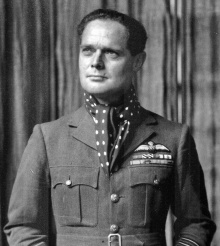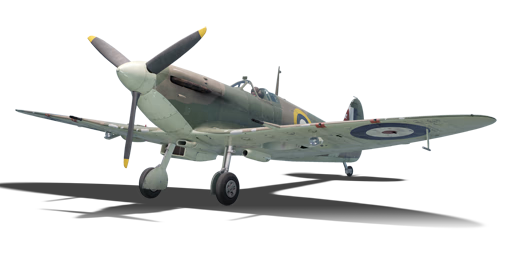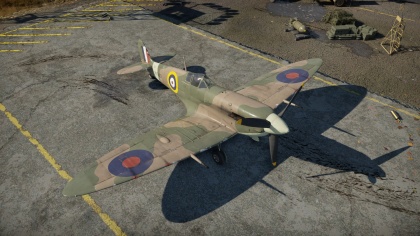Difference between revisions of "Spitfire Mk Vb"
(Edits.) |
m (Edits.) |
||
| Line 243: | Line 243: | ||
<div><ul> | <div><ul> | ||
| − | <li style="display: inline-block;"> [[File:Douglas_Bader_profile.jpg|thumb|none|220px|User:U64962917#Bader,_Douglas_R.S.B.|'''[[User:U64962917#Bader,_Douglas_R.S.B.|Douglas Bader]]''' flew the '''Spitfire Mk Va''' which differed from the '''Mk Vb''' in that the Vb had two 20 mm cannons and the Va did not, instead two .303 machine guns for eight total.]] </li><!-- | + | <li style="display: inline-block;"> [[File:Douglas_Bader_profile.jpg|thumb|none|220px|User:U64962917#Bader,_Douglas_R.S.B.|'''[[User:U64962917#Bader,_Douglas_R.S.B.|Douglas Bader]]''' flew the '''Spitfire Mk Va''' which differed from the '''Mk Vb''' in that the Vb had two 20 mm cannons and the Va did not, instead two more .303 machine guns for eight total.]] </li><!-- |
<li style="display: inline-block;"> [[File:X.jpg|thumb|none|200px|"Image Description"]] </li> | <li style="display: inline-block;"> [[File:X.jpg|thumb|none|200px|"Image Description"]] </li> | ||
<li style="display: inline-block;"> [[File:X.jpg|thumb|none|200px|"Image Description"]] </li> | <li style="display: inline-block;"> [[File:X.jpg|thumb|none|200px|"Image Description"]] </li> | ||
Revision as of 14:49, 3 July 2019
Contents
| This page is about the British fighter Spitfire Mk Vb. For other uses, see Spitfire (Family). |
Description
The Spitfire Mk Vb is a Rank British fighter
with a battle rating of (AB), (RB), and (SB). This fighter was introduced in Update 1.77 "Advancing Storm".
The Spitfire fills the turn-fighter class in the British line. It can perform many fighting tactics, such as energy fighting as well as turn-fighting. It has an impressive climb rate and turn time.
General info
Flight Performance
Describe how the aircraft behaves in the air. Maximum speed, manoeuvrability, speed and allowable loads - these are the most important characteristics of the vehicle.
| Characteristics | |||||||
|---|---|---|---|---|---|---|---|
| Stock | |||||||
| Max Speed (km/h at 4,878 m) |
Max altitude (meters) |
Turn time (seconds) |
Rate of climb (meters/second) |
Take-off run (meters) | |||
| AB | RB | AB | RB | AB | RB | ||
| 57 | ? | 10,500 | 17.6 | ??.? | 13.6 | ??.? | 340 |
| Upgraded | |||||||
| Max Speed (km/h at 4,878 m) |
Max altitude (meters) | Turn time (seconds) | Rate of climb (meters/second) |
Take-off run (meters) | |||
| AB | RB | AB | RB | AB | RB | ||
| ? | ? | 10,500 | ??.? | ??.? | ?.? | ?.? | 340 |
Details
| Features | ||||
|---|---|---|---|---|
| Combat flap | Take-off flap | Landing flap | Air brakes | Arrestor gear |
| X | X | ✓ | X | X |
| Limits | ||||
|---|---|---|---|---|
| Wing-break speed (km/h) |
Gear limit (km/h) |
Combat flap (km/h) |
Max Static G | |
| + | - | |||
| ??? | ??? | ??? | ~?? | ~? |
| Optimal velocities | |||
|---|---|---|---|
| Ailerons (km/h) |
Rudder (km/h) |
Elevators (km/h) |
Radiator (km/h) |
| < ??? | < ??? | < ??? | > ??? |
| Compressor (RB/SB) | ||
|---|---|---|
| Setting 1 | ||
| Optimal altitude | 100% Engine power | WEP Engine power |
| ?,??? m | ??? hp | ?,??? hp |
Survivability and armour
- 3 mm Steel - Armor plating around ammunition cases (each wing)
- 3 mm Steel - Armor plating propeller hub
- 1 mm Steel - Fore cockpit armour plate
- 4 mm Steel - Pilot's seat
- 7 mm Steel - Armor plate behind the pilot
- 6 mm Steel - Pilot's headrest
- 38 mm Bulletproof glass - Armored windscreen.
Armaments
Offensive armament
The Spitfire Mk Vb is armed with:
- 2 x 20 mm Hispano Mk.II cannon, wing-mounted (60 rpg = 120 total)
- 4 x 7.7 mm Browning .303 machine gun, wing-mounted (350 rpg = 1,400 total)
Usage in battles
The Mk.V variants of the Spitfire series does not have the upgraded Merlin 47, but instead the Merlin 45 and thus may have poorer performance compared to the LF Mk.IX. However, the Mk.V carries more powerful ordnance compared to LF Mk.IX. Its wings can sustain a lot of stress, keeping still at steep dives and tight turns. Its control surfaces are large which means it has considerable control even at higher speeds.
Manual Engine Control
| MEC elements | ||||||
|---|---|---|---|---|---|---|
| Mixer | Pitch | Radiator | Supercharger | Turbocharger | ||
| Oil | Water | Type | ||||
| Controllable | Not controllable | Not controllable | Not controllable | Separate | Not ontrollable | Not controllable |
Modules
| Tier | Flight performance | Survivability | Weaponry | ||
|---|---|---|---|---|---|
| I | Fuselage Repair | Radiator | Offensive 7 mm | Offensive 20 mm | |
| II | Compressor | Airframe | New 7 mm MGs | New 20 mm Cannons | |
| III | Wings Repair | Engine | Mk.II year 1942 | ||
| IV | Engine Injection | Cover | Mk.II year 1942 | ||
- 20 mm air target belts are essential for dealing effective damage with your small ammo count. The radiator is extremely useful to allow you to run WEP for longer. Other manoeuvrability upgrades are useful for turn fighting.
Pros and cons
Pros:
- Engine temperature is easy to control with cool down from red to white, only taking 10-20 seconds
- 20 mm cannons can easily destroy enemy fighters
- Short turn times
- Structurally strong, will survive steep turns
Cons:
- Low cannon ammunition count of 60 RPG
- Guns are wing mounted away from the centre, requires setting convergence and targeting discipline
History
Describe the history of the creation and combat usage of the aircraft in more detail than in the introduction. If the historical reference turns out to be too big, take it to a separate article, taking a link to an article about the vehicle and adding a block "/ History" (example: https://wiki.warthunder.com/(Vehicle-name)/History) and add a link to it here using the main template. Be sure to reference text and sources by using <ref>, as well as adding them at the end of the article.
In-game description
"A single-seat, single-engine all-metal monoplane fighter. After the Mk II and two more experimental variants of the Spitfire, the next major variant to see mass production was the Spitfire Mk V. Central to this new Spitfire was its engine – the 1470 HP Rolls Royce Merlin 45. This was equipped with a single stage supercharger and, coupled with a new carburettor design, allowed the Mk V to perform zero G manoeuvres without starving the fuel flow to the engine; a problem which had plagued earlier models of the Spitfire. The engine change necessitated strengthening the engine housing and installing a more effective oil radiator with a circular rather than U-shaped housing, and fitting two strengthening longerons to the upper surfaces of each wing.
The Mk V initially followed a similar pattern to the Mk I and Mk II in that it was fitted either with the Type A or Type B wing, again carrying eight machine guns or two cannon and four machine guns respectively. Less than 100 of the Mk VA were produced; it would be the Mk VB with its formidable 20mm cannon and four machine guns which would be the major production model, with 3911 VBs manufactured.
Some of the fighters were made for tropical climate conditions: a Vokes filter was installed over the carburettor air intake, under the engine. It was covered by special “lips” which helped prevent excessive dust intake, but at the cost of top speed and rate of climb. This variant was named the Spitfire Mk VB/Trop and was used in the Mediterranean theatre of operations, especially North Africa and Malta.
The first Mk Vs entered combat in February of 1941. The improved power and performance characteristics of the Spitfire Mk V made it a competitive match for the new German Messerschmitt Bf109F, but it was found to be inferior to the new Focke-Wulf FW190. As a result, the Spitfire Mk V was the first variant to experiment with the option of clipped wing tips, which increased the aircraft’s roll rate and top speed at low level, but sacrificed its rate of climb.
The Mk V formed the backbone of RAF Fighter Command across several theatres of operations, and was considered by some pilots to be the definitive model of the Spitfire. "
Notable pilots
-
 Douglas Bader flew the Spitfire Mk Va which differed from the Mk Vb in that the Vb had two 20 mm cannons and the Va did not, instead two more .303 machine guns for eight total.
Douglas Bader flew the Spitfire Mk Va which differed from the Mk Vb in that the Vb had two 20 mm cannons and the Va did not, instead two more .303 machine guns for eight total.
Media
An excellent addition to the article will be video guides, as well as screenshots from the game and photos.
See also
Links to the articles on the War Thunder Wiki that you think will be useful for the reader, for example:
- reference to the series of the aircraft;
- links to approximate analogues of other nations and research trees.
External links





